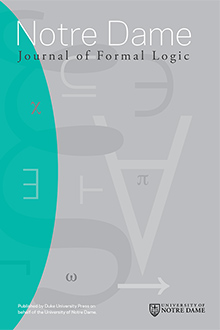Abstract
Reverse mathematics (RM hereafter) is a program in the foundations of mathematics founded by Friedman and developed extensively by Simpson and others. The aim of RM is to find the minimal axioms needed to prove a theorem of ordinary, that is, non-set-theoretic, mathematics. As suggested by the title, this paper deals with two (relatively rare) RM-phenomena, namely, splittings and disjunctions. As to splittings, there are some examples in RM of theorems , , such that , that is, can be split into two independent (fairly natural) parts and . As to disjunctions, there are (very few) examples in RM of theorems , , such that , that is, can be written as the disjunction of two independent (fairly natural) parts and . By contrast, we show in this paper that there is a plethora of (natural) splittings and disjunctions in Kohlenbach’s higher-order RM.
Citation
Sam Sanders. "Splittings and Disjunctions in Reverse Mathematics." Notre Dame J. Formal Logic 61 (1) 51 - 74, January 2020. https://doi.org/10.1215/00294527-2019-0032
Information





